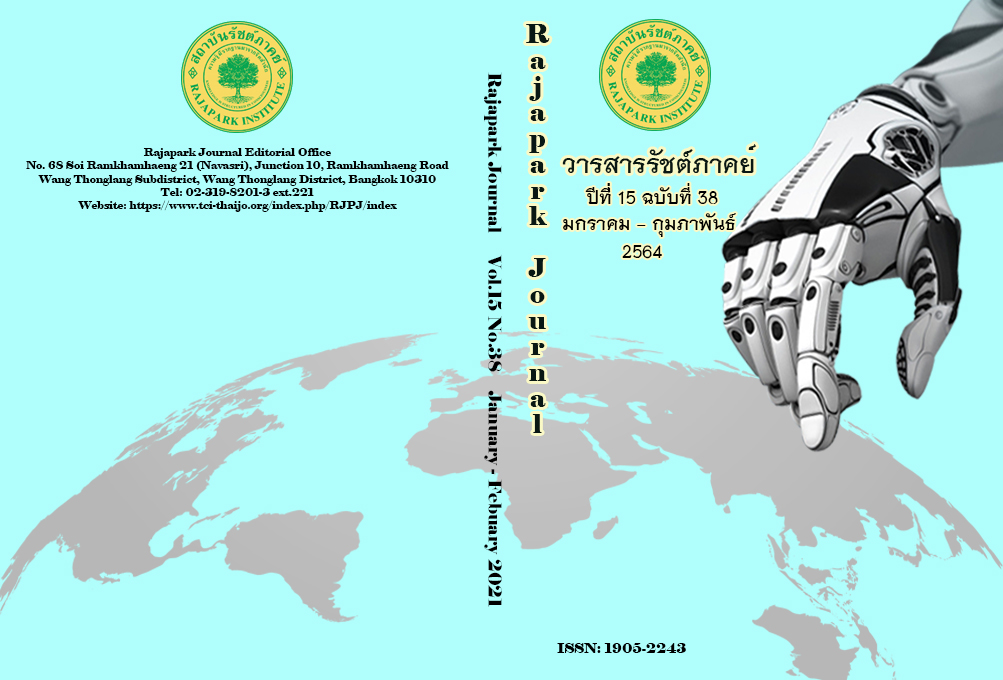Commercial Fisheries Management in Ranong Province
Main Article Content
Abstract
The objectives of this research were (1) to study the commercial fisheries management process in Ranong province, and (2) to study the results of the commercial fisheries management process in the implementation in Ranong province. This research used qualitative methods with in-depth interviews conducted with 27 key informants, participatory and non-participatory observations, and descriptive data analysis. The results show that the processes used within the management of commercial fisheries in Ranong province include the collection of fishing boat data, the analytical process, the planning and decision-making process, the allocation of resources for artisanal and commercial fisheries, the determination and enforcement of regulations for the restoration and control of commercial fisheries, and the presence of relevant agencies to regulate the behavior of fishermen. As a result of these processes, the problems related to the fisheries of Ranong province have been successfully resolved. Fisheries professionals have shown their desire to engage with the state to manage fisheries. At the same time, there are new problems that need to be addressed, including the problem of documenting a large number of boats and fisheries workers, the illegal presence of commercial fishing boats in the coastal sea area, the illegal presence of the artisanal fishing boats in the area preserved for the commercial fishing vessels, the quality and the monthly cost of ship-tracking equipment, the delay in the allocation of budget by the government to purchases the fishing boats, and the rising cost of fishing operations.
Article Details
Views and opinions appearing in the Journal it is the responsibility of the author of the article, and does not constitute the view and responsibility of the editorial team.
References
Ali, J., & Abdullah, H. (2010). Impact of Enforcement and Co-Management on Compliance Behavior of Fishermen. International Journal of Economics and Finance, 2(4), 113-121.
Chantavanich, S., Jarayabhand, P., Tingsabadh, C., Sittitrai, W., Yothinneeranath, P., Kuikaew, P., Makcharoen, P., & Neelapaichit, K. (2017). The Report of Policy Development on the Problems of Illegal, Unreported and Unregulated Fishing, Forced Labour and Human Trafficking in Sea Fisheries in 2016. Bangkok: Asian Research Center for Migration-Institute of Asian Studies, Chulalongkorn University.
Da Rocha, J. M., Cerviño, S., & Villasante, S. (2012). The Common Fisheries Policy: An enforcement problem. Marine Policy, 36(6), 1309-1314. DOI: 10.1016/j.marpol.2012.02.025
Department of Marine and Coastal Resources, Ministry of Natural Resources and Environment. (2013). Central Database System and Data Standard for Marine and Coastal Resources. Retrieved July 1, 2019, from https://km.dmcr.go.th/th/c_56/s_77/d_2766
Fisheries Development Policy and Strategy. (2019). Thai Fishing Vessels Strategy 2018. Retrieved July 21, 2020, from https://www4.fisheries.go.th/index.php/doffile/fkey/ref59679
Fish Marketing Organization. (2018). Fisheries Record 2018. Retrieved July 21, 2020, from http://www.fishmarket.co.th/index.php?option=com_content&view=category&id=44&Itemid=356
Food and Agriculture Organization of the United Nations (FAO). (2011). Fisheries management. Rome: FAO, United Nations.
Food and Agriculture Organization of the United Nations (FAO). (2012). The state of world fisheries and aquaculture 2012. Rome: FAO, United Nations.
Food and Agriculture Organization of the United Nations (FAO). (2016). In brief: The state of world fisheries and aquaculture: Contributing to food security and nutrition for all. Rome: FAO, United Nations.
Hoimuk, S., Keereerut, P., Jaiyen, T., Krajangdara, T., & Singtongyam, W. (2016). Marine Resources from Research Vessel in the Andaman Sea Coast of Thailand in 2006. Phuket: Andaman Sea Fisheries Research and evelopment Center (Phuket).
Nation Oceanic and Atmospheric Administration (NOAA). (2014). Definition term: Co-management. Retrieved July 21, 2020, from https://definedterm.com/co_management
Njaya, F. J. (2018). Ecosystem approach to fisheries in southern Lake Malawi: Status of the fisheries co-management. Aquatic Ecosystem Health & Management, 21(2), 159-167.
Njock, J. C., Allison, E. H., Westlund, L., & Konan, A. (2007). Innovations in fisheries co-management, and the challenge of mobility. In Wramner, P. Cullberg, M., & Ackefors, H. (Eds.), Fisheries, sustainability and development (pp. 267-279). Stockholm: Royal Swedish Academy of Agriculture and Forestry.
Phothisai, A. (2017). Measures and preventive measures against illegal fishing in Thailand and the key principles of IUU Fishing. Junniti Journal, 14(4), 149-161.
Ranong Fisheries Provincial Office. (2010). Ranong fisheries provincial office of work report 2010. Retrieved July 22, 2020, from https://www4.fisheries.go.th/local/index.php/main/site/fpo-ranong
Rodwell, L. D., Lowther, J., Hunter, C., & Mangi, S. C. (2014). Fisheries co-management in a new era of marine policy in the UK: A preliminary assessment of stakeholder perceptions. Marine Policy, 45, 279-286. ttps://doi.org/10.1016/j.marpol.2013.09.008
THAIPUBLICA. (2017, January 7). One year eight months: IUU fishery problems – Marine department has reduced the number of ships in one years. Through section 44 including withdraw 1.7 thousand ships into overfishing. Retrieved July 1, 2019, from https://thaipublica.org/2017/01/iuu2560-1/
Thairath Online. (2019, January 8). Urgent! Thai fisheries, the European Union has announced the withdrawal of the IUU yellow card for Thailand. Retrieved July 1, 2019, from https://www.thairath.co.th/news/foreign/1464816
Tokrisna, R. (2015). Coastal and Marine Resource Management: Marine Fishery Resources. Bangkok: National Research Council of Thailand (NRCT).


